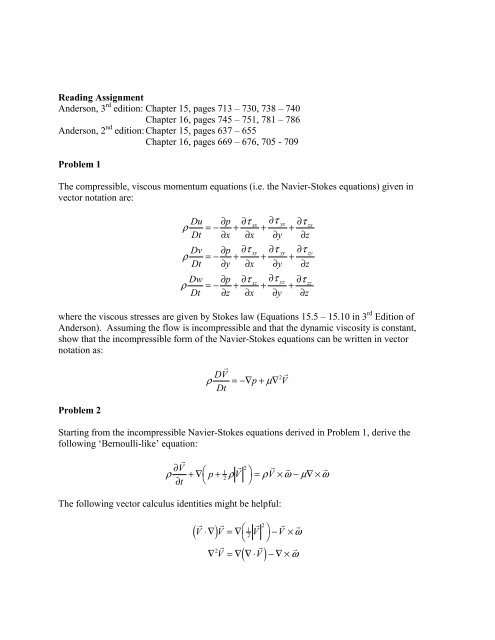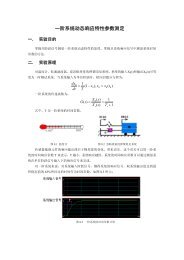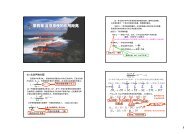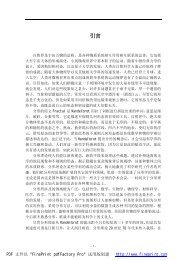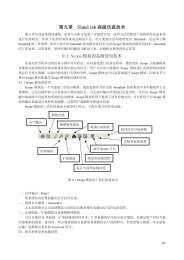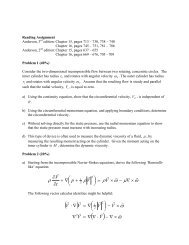Assume that the local skin friction coefficient in turbulent flow is ...
Assume that the local skin friction coefficient in turbulent flow is ...
Assume that the local skin friction coefficient in turbulent flow is ...
- No tags were found...
You also want an ePaper? Increase the reach of your titles
YUMPU automatically turns print PDFs into web optimized ePapers that Google loves.
Read<strong>in</strong>g AssignmentAnderson, 3 rd edition: Chapter 15, pages 713 – 730, 738 – 740Chapter 16, pages 745 – 751, 781 – 786Anderson, 2 nd edition: Chapter 15, pages 637 – 655Chapter 16, pages 669 – 676, 705 - 709Problem 1The compressible, v<strong>is</strong>cous momentum equations (i.e. <strong>the</strong> Navier-Stokes equations) given <strong>in</strong>vector notation are:Du p τ τxx yx τzxρ =− ∂ Dt ∂ x + ∂ + ∂ + ∂ ∂x ∂y ∂zDv p τxyτyyτzyρ =− ∂ Dt ∂ y + ∂ + ∂ + ∂ ∂x ∂y ∂zDw p τ τxz yz τzzρ =− ∂ Dt ∂ z + ∂ + ∂ + ∂ ∂x ∂y ∂zwhere <strong>the</strong> v<strong>is</strong>cous stresses are given by Stokes law (Equations 15.5 – 15.10 <strong>in</strong> 3 rd Edition ofAnderson). Assum<strong>in</strong>g <strong>the</strong> <strong>flow</strong> <strong>is</strong> <strong>in</strong>compressible and <strong>that</strong> <strong>the</strong> dynamic v<strong>is</strong>cosity <strong>is</strong> constant,show <strong>that</strong> <strong>the</strong> <strong>in</strong>compressible form of <strong>the</strong> Navier-Stokes equations can be written <strong>in</strong> vectornotation as:Problem 2rDVrρ =−∇ p+ µ ∇ 2 VDtStart<strong>in</strong>g from <strong>the</strong> <strong>in</strong>compressible Navier-Stokes equations derived <strong>in</strong> Problem 1, derive <strong>the</strong>follow<strong>in</strong>g ‘Bernoulli-like’ equation:Fr∂Vρ ρ ρ ω µ ω∂ +∇ H+r 2K = r × r − ∇× r1p2V VtThe follow<strong>in</strong>g vector calculus identities might be helpful:diIr r r 2 r rV ⋅∇ V =∇F V VrH1 I2rK− × ω2r∇ V =∇ ∇⋅V−∇× ωdi
Problem 3Start<strong>in</strong>g from <strong>the</strong> <strong>in</strong>compressible Navier-Stokes equations derived <strong>in</strong> Problem 1, derive <strong>the</strong>follow<strong>in</strong>g equation for <strong>the</strong> evolution of <strong>the</strong> vorticity:rDωr r2r= bω⋅∇ gV+ ν∇ωDtProblem 4p aυ wp bLConsider <strong>the</strong> 2-D <strong>flow</strong> between two porous walls of length L at y =± h. <strong>Assume</strong> <strong>that</strong> <strong>the</strong> lengthof <strong>the</strong> walls <strong>is</strong> much larger than <strong>the</strong> half-height h so <strong>that</strong> <strong>the</strong> <strong>flow</strong> may be assumed to be constant<strong>in</strong> <strong>the</strong> x-direction. The upper wall produces a suction such <strong>that</strong> <strong>the</strong> velocity normal to <strong>the</strong> wall <strong>is</strong>υ wand <strong>is</strong> positive. Solve <strong>the</strong> <strong>in</strong>compressible Navier-Stokes equations to f<strong>in</strong>d <strong>the</strong> velocity andpressure everywhere <strong>in</strong> duct for <strong>the</strong> case <strong>in</strong> which <strong>the</strong> pressure <strong>in</strong>let and exit of <strong>the</strong> pipe arep aand p b, respectively. Specifically, you should f<strong>in</strong>d <strong>the</strong> follow<strong>in</strong>g solution for <strong>the</strong> x-velocity:uu0FHGRe Re2 y e − e yh= − 1+Re h s<strong>in</strong>h Rewhere u 0<strong>is</strong> a constant <strong>that</strong> you must determ<strong>in</strong>e as part of <strong>the</strong> solution and <strong>the</strong> Reynolds number<strong>in</strong> th<strong>is</strong> problem <strong>is</strong> def<strong>in</strong>ed asRe = υ h wνIKJShow <strong>that</strong> for <strong>the</strong> case of low Reynolds number (i.e. small blow<strong>in</strong>g), <strong>the</strong> solution returns to <strong>the</strong>parabolic velocity profile for Po<strong>is</strong>euille <strong>flow</strong>. Do th<strong>is</strong> by carefully tak<strong>in</strong>g <strong>the</strong> limit of <strong>the</strong> velocityas Re → 0 .Show <strong>that</strong> for very large Reynolds number, <strong>the</strong> x-velocity (except near <strong>the</strong> walls) <strong>is</strong>approximately,uu0FReH G I K J2 y ≈ 1+h


